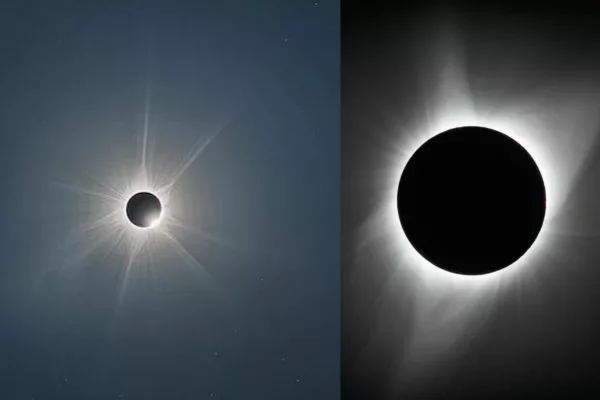On April 8, Monday, a total solar eclipse is set to cross North America, reported NASA. This will offer thousands of lakhs of people a rare opportunity to see darkened afternoon skies for a temporary period. This would occur when the moon blocks the face of the sun.
The path of the eclipse cuts across a tiny part of eastern Canada, 15 U.S. states and Mexico. In the rest of of the world, people can witness a partial solar eclipse. It will make the moon appear like taking a bite “out of the sun and obscuring part of its light.”
Stay tuned to know everything about this rare celestial event.
Brief About Solar Eclipse
The solar Eclipse is a celestial event which occurs when the Earth, moon and the Sun align in a straight line. In this event, the moon takes the place between Earth and the Sun. This also blocks the light of the sun.
A total solar eclipse is regarded as a celestial event in which the moon “fully obscures the sun.” However, in a partial solar eclipse, the moon partially obscures the sun, blocking only a part of it.
The director of the Hayden Planetarium at the American Museum of Natural History, Neil DeGrasse Tyson told NBC News, “Imagine if the moon’s orbit were in the plane of Earth’s orbit around the sun — if that were the case, then every new moon, you’d have a total solar eclipse and every full moon, you’d have a lunar eclipse.”
He added, “So, because things don’t always align, it lends to the rarity of the event and the specialness of the event.”
Solar Eclipse Partial and Total Visibility Areas
This year’s solar eclipse will be visible on a comparatively wider path than any othersolar eclipses in the recent past.’
As per estimates given by NASA, this year’s total eclipse will give 31.6 million people within its path of totality. Moreover, NASA added, “150 million people live within 200 miles of the route.”
The path of the eclipse travels through Maine, New Hampshire, Vermont, New York, Pennsylvania, Ohio, Indiana, Kentucky, Illinois, Missouri, Arkansas, Oklahoma, and Texas.
If conditions are clear, then small parts of Tennessee and Michigan will also witness the eclipse, reported The New Yorker.
In Canada, the eclipse will cross into Cape Breton, Prince Edward Island, New Brunswick, Quebec, southern Ontario, and the eastern end of Nova Scotia.
A partial solar eclipse will be visible to everyone. However, interested individuals can also participate in this celestial event by watching the NASA livestream or via McDonald Observatory in Texas.
The totality will last somewhere up to 4 minutes and 28 seconds.
Here are some of the Totality begin and end time given by NASA where total Solar Eclipse will be visible.
| Place | Totality begin Time | Totality end time |
|---|---|---|
| Dallas, Texas | 1:40 p.m. CDT | 1:40 p.m. CDT |
| Idabel, Oklahoma | 1:45 p.m. CDT | 1:49 p.m. CDT |
| Little Rock, Arkansas | 1:51 p.m. CDT | 1:54 p.m. CDT |
| Poplar Bluff, Missouri | 1:56 p.m. CDT | 2:00 p.m. CDT |
| Paducah, Kentucky | 2:00 p.m. CDT | 2:02 p.m. CDT |
| Carbondale, Illinois | 1:59 p.m. CDT | 2:03 p.m. CDT |
| Evansville, Indiana | 2:02 p.m. CDT | 2:05 p.m. CDT |
| Cleveland, Ohio | 3:13 p.m. EDT | 3:17 p.m. EDT |
| Erie, Pennsylvania | 3:16 p.m EDT | 3:20 p.m EDT |
| Buffalo, New York | 3:18 p.m. EDT | 3:22 p.m EDT |
| Burlington, Vermont | 3:26 p.m EDT | 3:29 p.m EDT |
| Lancaster, New Hampshire | 3:27 p.m EDT | 3:30 p.m. EDT |
| Caribou, Maine | 3:32 p.m. EDT | 3:34 p.m. EDT |
How To Safely View A Solar Eclipse?
Gazing at the sun directly can never be safe. Thus, gazing at the sun when it is mostly or partly covered by the moon is also not very safer. According to NASA, if people fail to take proper precautions, then a severe eye injury can be a repercussion.
To view the solar eclipse, pinhole projectors and special eclipse glasses are the required tools which prevent eye damage by giving an opportunity to safely view solar eclipses.
Eclipse glasses are designed “thousands of times darker than normal sunglasses.” These glasses are made specially for the wearer to gaze at the sun.
Unless and until specific solar filters are not attached to camera lenses, telescopes or binoculars of the sky-watchers, then they should refrain themselves from viewing the Sun.
However, there is a twist here. At the time of totality, when the moon blocks the sun fully, then it’s safe to look at the eclipse with the naked eye.
Total Solar Eclipse Lookouts Guide
CNET reported that, as the total solar eclipse uncovers, people staying along the path of totality have various fun milestones to watch out for.
According to Tyson, “as the eclipse progresses and the sun gets thinner in the sky, it will start to get eerily dark.”
When the concluding rays of the sun starts concealing, “diamond ring effect” can be watch out for.
Diamond ring effect is regarded as a celestial event in which the sun’s atmosphere appears like an illuminated halo. Thus, the last light that is still visible looks like “diamond of a giant ring.”
When the sunlight decreases even further, moon’s rugged terrain creates an effect known as “Baily’s beads”. Around the dark moon, for a few seconds, only tiny beads of light can be seen.
Sky-watchers who would be lucky can also catch a glimpse of a comet. However, the majority of eyes will be on the moon and sun alignment.
Tyson said, “Most people won’t even notice. But if you know where to look, it’s there.”
Next Solar Eclipse
The upcoming total solar eclipse will be in 2026. Notably, it will pass mostly over the Arctic Ocean. Northern Spain, Portugal, Iceland and Greenland will also have some visibility.
Spain will witness a total solar eclipse in 2027 along with a broader part of northern Africa. Then in 2033, 2044 and 2045 the total solar eclipse is scheduled to be visible.
Also Read: Who is “Living Nostradamus” Athos Salomé And What Are His Predictions For 2024?

 WATCH: 2016 surveillance video reveals chilling details of Sean ‘Diddy’ Combs physically assaulting Cassie Ventura
WATCH: 2016 surveillance video reveals chilling details of Sean ‘Diddy’ Combs physically assaulting Cassie Ventura Forbes 30 Under 30 Asia List Out, These Indians Made It On The List
Forbes 30 Under 30 Asia List Out, These Indians Made It On The List Jasmine Crockett Net Worth 2024: How Much is the United States Representative Worth?
Jasmine Crockett Net Worth 2024: How Much is the United States Representative Worth? New COVID-19 Variant Alert! KP.2 Can Bypass Your Immunity—How You Can Protect Yourself, Learn Everything
New COVID-19 Variant Alert! KP.2 Can Bypass Your Immunity—How You Can Protect Yourself, Learn Everything #Blockout2024: Why are A-Grade Celebrities Being Blocked And Reported On Social Media?
#Blockout2024: Why are A-Grade Celebrities Being Blocked And Reported On Social Media? Burnsview Secondary School Placed Under Lockdown For Prank Call, Investigation Underway
Burnsview Secondary School Placed Under Lockdown For Prank Call, Investigation Underway  Flagstaff Shooting At Bushmaster Park In Arizona, Armed and Dangerous Suspect Arrested
Flagstaff Shooting At Bushmaster Park In Arizona, Armed and Dangerous Suspect Arrested Lawsuit Slapped Against Chicago-Area Teacher And High School For Childhood Sexual Abuse
Lawsuit Slapped Against Chicago-Area Teacher And High School For Childhood Sexual Abuse